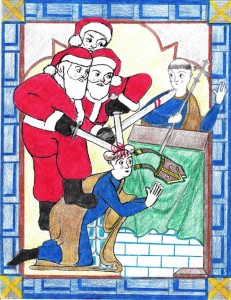How To Commit a Perfect Crime
December 29, 1170: Thomas Becket Gets a Halo to Cover a Split Skull
 Henry II, King of England and half of France, had an unusual Christmas wish in 1170. “Will no one rid me of this turbulent priest?” Four of his barons couldn’t think of a better gift for their king, so they left the medieval equivalent of comfort in a Norman castle, crossed the English Channel, rode to Canterbury and got rid of that turbulent priest. Evidently, there was only one clergyman who fit that description: Thomas Becket.
Henry II, King of England and half of France, had an unusual Christmas wish in 1170. “Will no one rid me of this turbulent priest?” Four of his barons couldn’t think of a better gift for their king, so they left the medieval equivalent of comfort in a Norman castle, crossed the English Channel, rode to Canterbury and got rid of that turbulent priest. Evidently, there was only one clergyman who fit that description: Thomas Becket.
The relationship between the Becket and Henry has long fascinated historians and, since Freud and Kinsey, it has titillated psychologists, too. The men had been friends. Becket (1118-well, you know) had also proved himself an excellent and canny administrator, rising in the bureaucratic ranks to be Chancellor of England. As Chancellor, Becket had been a fierce advocate of the Crown in its longstanding duel with the Church over legal prerogatives and taxes. (During the reign of Henry’s inept predecessor Stephen, the Church had usurped a number of rights and jurisdictions; Henry really was trying to reestablish the original rights of the Crown.) But the Church was reluctant to give up even its dubious claims. So, in 1162 when the Archbishop of Canterbury died, Henry imagined that he had a devilishly brilliant plan. He would name his pal and partisan Tom Becket to be the new Archbishop. With his man as England’s primate, the Church finally would cede its usurped rights and properties. So Henry thought….
But the new Archbishop now had a new allegiance, and he became a zealous defender of the Church. Becket not merely refused to compromise; he threatened. The Archbishop would have given out excommunications as if they were alms. In 1164, negotiators for the Church and Crown reached an agreement known as the Constitutions of Clarendon. Its terms were to settle the various disputes, generally in the Crown’s favor. (The Church would return most of its “hot” properties.) While the other bishops signed the pact, Becket refused. He deferred his assent, saying that the Constitutions would require the Pope’s approval.
In case you were wondering, Becket had studied law. He knew how to delay and sabotage with the appearance of utmost propriety. Who could object to the Pope’s approval? Of course, Rome was not conveniently close and Pope Alexander III could be difficult to find; he was on the run from the German armies of Emperor Frederick Barbarossa. Becket was prepared to wait but not necessarily in prison; however, that was where Henry intended to send his ex-friend. The Archbishop preferred an indefinite stay on the continent, first going to Italy and dragging the Pope into the quarrel.
Hounded by German armies, Alexander III really did not need to resolve who got which fen in Dorset. Yes, in principle he sided with the Archbishop but he saw no need to make the king an implacable enemy. Alexander III had studied law, too. The Pope’s compromise was to reject this draft of the conventions and, at the same time, put that annoying Becket on probation. The Archbishop would spend the next six years in reflection at French monasteries. So, without Becket’s intransigent presence, the Crown and the Church could continue their negotiations.
But Becket was just as intransigent in absentia. One can write excommunications as well as pronounce them. (The Pope was obliged to nullify Becket’s damnations.) However, in 1170 the Pope and Henry reached a compromise. Part of the agreement included allowing Thomas Becket to return to Canterbury. The Archbishop spend his Christmas announcing new excommunications, and you know Henry’s response.
“Who will rid me of this turbulent priest?” Henry said it, but Pope Alexander III was definitely thinking it. In fact, his Holiness probably committed the perfect crime. He knew that Becket could drive anyone to murder, and Henry was never a paragon of self-restraint. Becket gets killed, the Church loses a nuisance and gains a martyr, Henry gets the blame and has to pay off in concessions to the Church. That is exactly what happened.
As a statesman, Alexander III was one of the greatest popes–and you’ll noticed that he never was canonized.
The illustration “A Henry II Christmas” is the delightful work of Nadine Eastwood.